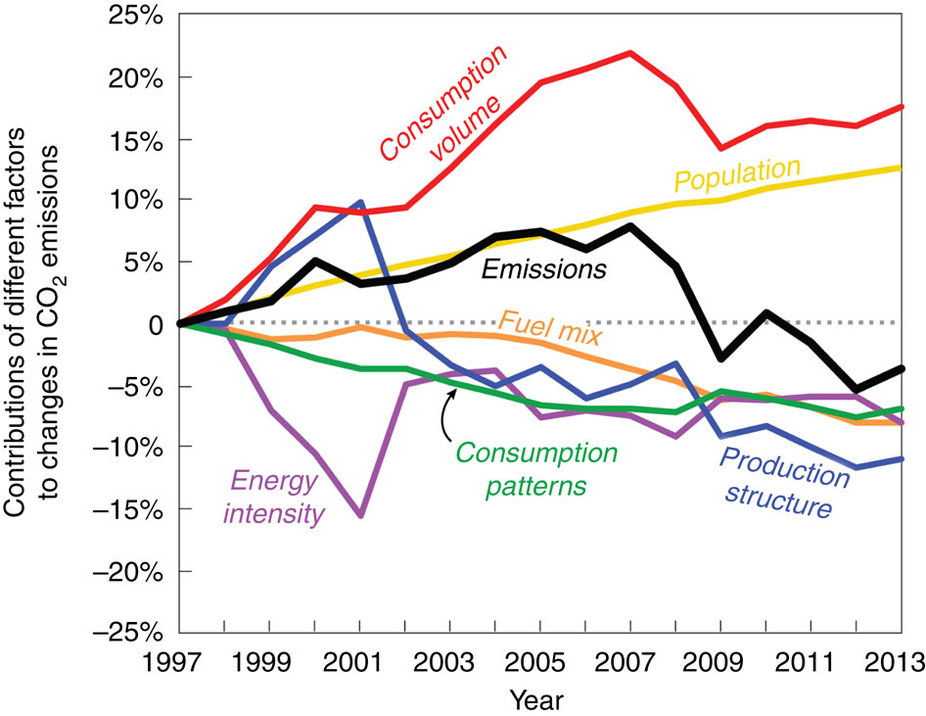
Fracking, the process of horizontal drilling into shale layers with slickwater injection, hydraulic fracturing, and subsequent gas (and oil) extraction, has dramatically increased US natural gas production in the last 10+ years. As much of the newly produced natural gas is burned in new power plants for electricity production, it has replaced a significant amount of electricity produced in coal-fired power plants. But that is not the dominant reason why US carbon emissions have been dropping. The main reasons US CO2 emissions have been dropping since 2007 is a combination of the recession (demand decline), improvements of energy efficiency/intensity, and the lowering of "carbon intensity" (expressed more simply as the amount of CO2 emitted per kWh electricity produced). However, there is a persistent myth that US carbon dioxide emissions are dropping mainly because of dropping carbon intensity, promulgated e.g. by popular press articles such as this one.
A widely acknowledged research paper by Feng et al. (2015) from the University of Maryland, UC Irvine, and IIASA, published in Nature Communications in July 2015, lays out the details of how US CO2 emissions dropped. We are displaying Figure 1 below, which summarizes the results by showing the different sectors contributing to dropping CO2 emissions (arbitrarily anchored at the start year).

Figure 1 from Feng et al., July 2015, Nature Communications, doi:10.1038/ncomms8714
The drop in the black curve after 2007 is in large parts due to a lack of "consumption volume" (red curve: demand decline) and a subsequent drop in "production structure" (blue curve: efficiency increase). The third contributor is the "fuel mix" (orange curve: carbon intensity). This has been understood for a while now, and was reaffirmed through a comment-and-reply discussion in the journal. Similar works by the Yale Climate Forum and a recent report by the White House Council of Economic Advisors (CEA). There was even a good summary in the Economist.
The reality is that
Approximately one third of the US carbon dioxide emissions drop since 2007 is due to changes in electricity production away from coal combustion toward natural gas and renewable energy use.
In the alternate reality of the fossil fuel industry and its front groups, however, this third could be thought of as the whole story if one reads only the headlines. And the right-wing press is quick to highlight fracking as the dominant source of declining emissions.
While denialists such as Bjørn Lomborg predictably misinform, curiously, only the headlines but not the numbers in the right-wing press are lying ... once the carbon-intensity third is multiplied by the fraction of energy-production related drops that directly results from natural gas replacing coal, approximately two thirds, the contribution to total reductions from natural gas is around 20%.
Not surprisingly, left-wing think tank ThinkProgress shot back through reprinting a detailed CO2ScoreCard article, which laid out a series of calculations based on the available data, and, though slightly outdated now, got it right in 2012.
In conclusion, one has to read articles on dropping carbon dioxide emissions in the US carefully to distinguish between "energy-related" CO2 emissions, and "US CO2 emissions". The US Energy Information Administration (EIA) deals only with the former.
We have discussed US methane emissions in a recent article, and there is no doubt that oil and gas exploration related methane emissions present a significant offsetting factor to US carbon dioxide emission reductions. Though the US fracking boom is likely not responsible for the parallel increase in global atmospheric methane, it is likely higher than inventoried, affecting global ethane and higher hydrocarbons, including air toxics. In turn, burning natural gas is much cleaner than burning coal, reducing other air pollutants such as PM, SO2, and NOx.
Much of the discussion about natural gas and its greenhouse effects thus relates to local vs. global and short-term vs. long-term impacts, with some of the science still developing.
There is no doubt that in terms of carbon dioxide and some of the EPA criteria pollutant emissions, natural gas is much preferable to coal. However, its role is often exaggerated in the media and by fossil fuel industry front groups. Investing heavily in natural gas exploration can only lower CO2 emissions as long as it occurs at the expense of coal. But the newly built infrastructure is expensive, and must be monitored for leaks continuously to prevent offsetting effects from methane emissions. It also represents a long-term investment not made into more effective replacements for coal, namely renewable energy. There is a real risk that the US locks itself into a natural gas future, which cannot deliver the deep carbon cuts necessary for a two degrees maximum global warming goal. Referring to a recent UCS report, report co-author John Rogers was quoted saying
A big concern is committing to more natural gas infrastructure, and then figuring out 15 or 20 years down the road that we've got a lot more than we want or need and are on the hook to pay for it. [...] Another concern is, investments focused on natural gas will crowd out clean energy.
The role of natural gas as an element of a carbon dioxide reduction strategy should thus be determined carefully, not based on short-term fossil fuel interests only.
Posted by gws on Tuesday, 8 November, 2016
 |
The Skeptical Science website by Skeptical Science is licensed under a Creative Commons Attribution 3.0 Unported License. |